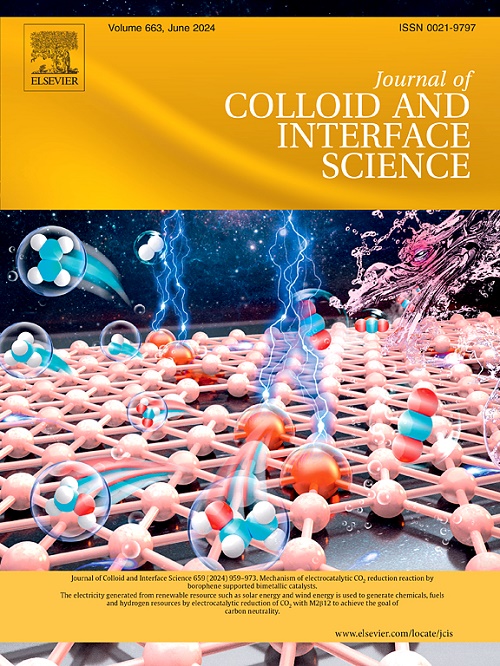Simultaneous modulation of double-coordination shells at cobalt atomic site towards superior oxygen electrocatalysis
IF 9.4
1区 化学
Q1 CHEMISTRY, PHYSICAL
引用次数: 0
Abstract
Engineering the coordination microenvironment surrounding the single atom sites (SA) presents a great opportunity to enhance their catalytic performance. In this work, we report the rational design of the cobalt SA sites with simultaneous modifications to the double coordination shells of the Co atom. In the first coordination shell, a vacancy is introduced to create the asymmetric Co-N3-V configuration, where V denotes the vacancy. Meanwhile, phosphorus (P) atoms are doped into the carbon substrate to regulate the local environment of the second shell surrounding the Co site. These simultaneous modifications to the double-shell coordination influence the charge density of the active centers, and ultimately improve their activities. Additionally, the one-dimensional (1D) carbon substrate, that is composed of connected bubbles (BCF), provides a conductive and porous framework that facilitates fast kinetics. Taking these advantages, the Co-N-V/P@BCF catalyst demonstrates exceptional bifunctional oxygen catalytic behavior. Furthermore, the robust mechanical properties of Co-N-V/P@BCF, as evidenced by finite element analysis (FEA), endow the full Zn-air battery (ZAB) with remarkable reliability, flexibility, and stable high-rate long-term performance under diverse operating conditions. Therefore, this work not only offers new insights into regulating the electronic structure of single-atomic sites, but also promotes the development of ZAB for various applications.

钴原子位双配位壳的同步调制对氧电催化的影响。
设计单原子位(SA)周围的配位微环境为提高它们的催化性能提供了一个很好的机会。在这项工作中,我们报告了钴SA位点的合理设计,同时修改Co原子的双配位壳层。在第一个配位层中,引入了一个空位,形成了不对称的Co-N3-V构型,其中V表示空位。同时,将磷(P)原子掺杂到碳底物中,调节Co位点周围第二壳层的局部环境。这些对双壳配位的同时修饰影响了活性中心的电荷密度,最终提高了活性中心的活性。此外,由连接气泡(BCF)组成的一维(1D)碳衬底提供了导电和多孔框架,促进了快速动力学。利用这些优点,Co-N-V/P@BCF催化剂表现出优异的双功能氧催化行为。此外,Co-N-V/P@BCF坚固的力学性能,通过有限元分析(FEA)证明,赋予全锌空气电池(ZAB)卓越的可靠性,灵活性和稳定的高速率长期性能,在不同的工作条件下。因此,这项工作不仅为调控单原子位的电子结构提供了新的见解,而且促进了ZAB在各种应用中的发展。
本文章由计算机程序翻译,如有差异,请以英文原文为准。
求助全文
约1分钟内获得全文
求助全文
来源期刊
CiteScore
16.10
自引率
7.10%
发文量
2568
审稿时长
2 months
期刊介绍:
The Journal of Colloid and Interface Science publishes original research findings on the fundamental principles of colloid and interface science, as well as innovative applications in various fields. The criteria for publication include impact, quality, novelty, and originality.
Emphasis:
The journal emphasizes fundamental scientific innovation within the following categories:
A.Colloidal Materials and Nanomaterials
B.Soft Colloidal and Self-Assembly Systems
C.Adsorption, Catalysis, and Electrochemistry
D.Interfacial Processes, Capillarity, and Wetting
E.Biomaterials and Nanomedicine
F.Energy Conversion and Storage, and Environmental Technologies
文献相关原料
公司名称
产品信息
麦克林
H3BO3
麦克林
ZnSO4·7H2O
麦克林
Copper acetate monohydrate
麦克林
NaH2PO2·H2O
麦克林
H3BO3
麦克林
ZnSO4·7H2O
麦克林
Copper acetate monohydrate
麦克林
NaH2PO2·H2O
麦克林
H3BO3
麦克林
ZnSO4·7H2O
麦克林
Copper acetate monohydrate
麦克林
NaH2PO2·H2O
阿拉丁
Polyvinylpyrrolidone (PVP)
阿拉丁
Polyvinylpyrrolidone
阿拉丁
Polyvinylpyrrolidone (PVP)

 求助内容:
求助内容: 应助结果提醒方式:
应助结果提醒方式:


